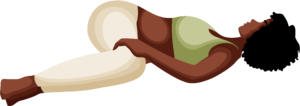Laying Spinal Twist (Jathara Parivartanasana)
Pose Overview
| Common Name | Laying Spinal Twist |
| Traditional Sanskrit Name | Jathara Parivartanasana |
| Sanskrit Name Pronunciation | JAH-tah-rah par-ee-var-tan-AHS-uh-nuh |
| Pose Difficulty | Beginner |
| Drishti
Drishti is the gaze or visual focus point during yoga poses.
Learn more about Drishti |
Over the shoulder |
Laying Spinal Twist, also known as Jathara Parivartanasana, is a restorative yoga pose that helps to release tension in the spine and improve flexibility. This pose is often used as a counterpose to backbends and can be performed as a way to relax and calm the mind after a more intense yoga practice. The pose is typically done on the floor, and it is a great way to stretch the back, hips, and shoulders.
Benefits of Laying Spinal Twist
Stretches the back, hips, and shoulders Releases tension in the spine Improves flexibility Calms the mind
How to Enter Laying Spinal Twist
Lie on your back and bring your knees up to your chest. Extend your arms out to the sides with your palms facing up. Let your knees fall to one side while keeping your shoulders and head on the floor. Breathe deeply and hold the pose for several breaths.
How to Exit Laying Spinal Twist
Slowly release your knees and bring them back to your chest. Carefully turn your head to the opposite side and release your arms. Take a few deep breaths and then repeat the pose on the opposite side.
Common Laying Spinal Twist Modifications & Variations
-If you have difficulty keeping your shoulders and head on the floor, you can use a pillow or folded blanket to support your head and shoulders. -If you have difficulty keeping your knees on the floor, you can use a yoga block or folded blanket to support your legs.
Common Mistakes with Laying Spinal Twist
-Not keeping the shoulders and head on the floor, which can strain the neck -Not keeping the knees on the floor, which can strain the hips
Safety Guidance
-Be sure to keep your shoulders and head on the floor and your knees on the floor to avoid straining the neck and hips. -If you have any neck or back injuries, be sure to check with your doctor before attempting this pose.

